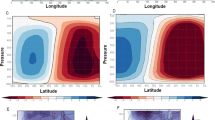Abstract
On the interannual timescale, the meridional displacement of the East Asian upper-tropospheric jet stream (EAJS) is significantly associated with the rainfall anomalies in East Asia in summer. In this study, using the data from the National Centers for Environmental Prediction-Department of Energy (NCEP/DOE) reanalysis-2 from 1979 to 2002, the authors investigate the interannual variations of the EAJS’s meridional displacement in summer and their associations with the variations of the South Asian high (SAH) and the western North Pacific subtropical high (WNPSH), which are dominant circulation features in the upper and lower troposhere, respectively. The result from an EOF analysis shows that the meridional displacement is the most remarkable feature of the interannual variations of the EAJS in each month of summer and in summer as a whole. A composite analysis indicates that the summer (June–July–August, JJA) EAJS index, which is intended to depict the interannual meridional displacement of the EAJS, is not appropriate because the anomalies of the zonal wind at 200 hPa (U200) in July and August only, rather than in June, significantly contribute to the summer EAJS index. Thus, the index for each month in summer is defined according to the location of the EAJS core in each month. Composite analyses based on the monthly indexes show that corresponding to the monthly equatorward displacement of the EAJS, the South Asian high (SAH) extends southeastward clearly in July and August, and the western North Pacific subtropical high (WNPSH) withdraws southward in June and August.
Similar content being viewed by others
References
Bell, G. D., and Coauthors, 2000: Climate assessment for 1999.Bull. Amer. Meteor. Soc.,81, 1–50.
Ding Yihui, 1992: Summer monsoon rainfalls in China.J. Meteor. Soc. Japan,70, 373–396.
Dole, R. M., and R. X. Black, 1990: Life cycles of persistent anomalies. Part II: The development of persistent negative height anomalies over the North Pacific Ocean.Mon. Wea. Rev.,118, 824–846.
Dong Min, Yu Jianrui, and Gao Shouting, 1999: A study of the variations of the westerly jet over East Asia and its relation with the tropical convective heating.Chinese J. Atmos. Sci.,23, 62–70. (in Chinese)
Gao Shouting, and Tao Shiyan, 1991: Acceleration of upper-tropospheric jet stream and low-tropospheric frontogenesis.Chinese J. Atmos. Sci.,15, 11–21. (in Chinese)
Hou, A. Y., 1998: Hadley circulation as a modulator of the extratropical climate.J. Atmos. Sci.,55, 2437–2457.
Kanamitsu, M., W. Ebisuzaki, J. Woollen, S-K Yang, J.J. Hnilo, M. Fiorino, and G. L. Potter, 2002: NCEP-DOE AMIP-II Reanalysis (R-2).Bull. Atmos. Meteor. Soc.,83, 1631–1643.
Krishnan, R., and M. Sugi, 2001: Baiu rainfall variability and associated monsoon teleconnections.J. Meteor. Soc. Japan,79, 851–860.
Kung, E. C., and P. H. Chan, 1981: Energetic characteristics of the Asian winter monsoon in the source region.Mon. Wea. Rev.,109, 854–870.
Lau, K. M., and J. S. Boyle, 1987: Tropical and extratropical forcing of the large-scale circulation: A diagnostic study.Mon. Wea. Rev.,115, 400–428.
Lau, K.-M., K.-M. Kim, and S. Yang, 2000: Dynamic and boundary forcing characteristics of regional components of the Asian summer monsoon.J. Climate,13, 2461–2482.
Lu Riyu, Jai-Ho Oh, Beak-Jo Kim, Hee-Jeong Beak, and Huang Ronghui, 2001: Associations with the interannual variations of onset and withdrawal of the Changma.Adv. Atmos. Sci.,18, 1066–1080.
Lu, Riyu, Jai-Ho Oh, and Beak-Jo Kim, 2002: A teleconnection pattern in the upper-level meridional wind over the North African and Eurasian continent in summer.Tellus,54A, 44–55.
Lu, Riyu, 2004: Associations among the components of the East Asian summer monsoon systems in the meridional direction.J. Meteor. Soc. Japan,82, 155–165.
Neyama, Y., 1963: On the dates of the transition of wind direction from west to east in the lower stratosphere at Marcus Island (24°17′N, 153°88′E) in late spring and the setting in of “Baiu” (the rainy season in Japan).Geophys. Mag.,31, 633–651.
Palmen, E., and C. W. Newton, 1969:Atmospheric Circulation Systems: Their Structure and Physical Interpretation. Academic Press, 603pp.
Tao Shiyan, and Chen Longxun, 1987: A review of recent research of the East Asian summer monsoon in China.Monsoon Meteorology, C.-P. Chang and T. N. Krishnamurti, Eds., Oxford University Press, 60–92.
Wu Guoxiong, Liu Xin, Zhang Qiong, Mao Jiangyu, Liu Yimin, Li Weiping, and Qian Yongfu, 2002: Progress in the study of the climate impacts of the elevated heating over the Tibetan Plateau.Climatic and Environmental Research,7, 184–201. (in Chinese)
Wu Renguang, 2002: A mid-latitude Asian circulation anomaly pattern in boreal summer and its connection with the Indian and East Asian summer monsoons.J. Climate,22, 1879–1895.
Yang, S., and P. J. Webster, 1990: The effect of summer tropical heating on the location and intensity of the extratropical westerly jet stream.J. Geophys. Res.,95, 18705–18721.
Yang, S., K.-M. Lau, and K.-M. Kim, 2002: Variations of the East Asian Jet Stream and Asian-Pacific-American winter climate anomalies.J. Climate,15, 306–325.
Yeh, T.-C., S.-Y. Tao, and M.-T. Li, 1959: The abrupt change of circulation over the Northern Hemisphere during June and October.The Atmosphere and the Sea in Motion, B. Bolin, Ed., Rockefeller Institute Press, 249–267.
Zeng Qingcun, 1979:Mathematical and Physical Basis for Numerical Weather Forecast. Science Press, 314pp.
Zhang Qiong, Wu Guoxiong, and Qian Yongfu, 2002: The bimodality of the 100 hPa South Asia High and its relation to the climate anomaly over East Asia in summer.J. Meteor. Soc. Japan,80, 733–744.
Zhang Yongshen, and Wu Guoxiong, 1999: Diagnostic investigation on the mechanism of the onset of Asian summer monsoon and abrupt seasonal transitions over the Northern Hemisphere. Part II: The role of surface sensible heating over Tibetan Plateau and surrounding regions.Acta Meteorologica Sinica,57, 56–73. (in Chinese)
Author information
Authors and Affiliations
Corresponding author
Rights and permissions
About this article
Cite this article
Zhongda, L., Riyu, L. Interannual meridional displacement of the East Asian upper-tropospheric jet stream in summer. Adv. Atmos. Sci. 22, 199–211 (2005). https://doi.org/10.1007/BF02918509
Received:
Revised:
Issue Date:
DOI: https://doi.org/10.1007/BF02918509




